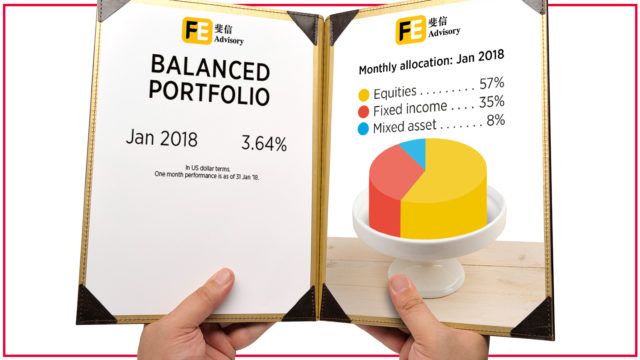Each month we feature the allocation in one of the three portfolios offered by FE Advisory Asia: cautious, balanced and growth. Data is included to show how well the portfolio has done compared to the previous month and year-to-date so that readers can get a sense of performance.
Additionally, Luke Ng, senior VP of research at FE Advisory Asia, provides a concise analysis on macro events and their potential impact on the portfolio.
A breakdown of the Balanced portfolio at the end of January 2018. Performance figures are in the menu image above.

Portfolio breakdown and holdings are based on latest published data for each constituent, which may have publication dates that differ.
Percentages are based on current holdings and should only be used as a guide. Some information is provided to FE from independent third parties whom FE does not control. FE cannot guarantee the accuracy or reliability of the data, or its suitability for use by all investors.

How did the market perform in January?
January proved another positive month for equity investors as encouraging macroeconomic data continued to drive the asset class higher across different markets. US dollar weakness benefited emerging market equities which saw strong net capital inflows. Backed by a sound backdrop, key markets including China, Brazil and Russia ranked amongst the top performers within their respective regions. They were also boosted by improving domestic growth data, encouraging political headlines and rising oil prices.
Developed market equities also made significant gains in January. In the US, the main driver was the news that average earnings had increased 2.5% year-on-year. Strong retail sales and robust employment figures also contributed to the growth. Meanwhile, Europe registered its highest annual growth since 2007. While the market momentum remained strong throughout the month, there were growing concerns that the monetary stance of the US Federal Reserve and the European Central Bank might become more hawkish than previously expected. These concerns intensified during the second half of the month with the ten-year US Treasury yield seeing a sharp uptick towards 2.8% by the month’s end.
How did the FE balanced portfolio perform?
Our FE Advisory balanced portfolio gained 3.64% in January, in US dollar terms. Our allocation in a small-cap-focused China dividend strategy benefited from a rally in Chinese equities, despite slightly underperforming the overall market as the rally was led primarily by growth stocks and larger caps. Still, the strategy was the top performing holding in the portfolio. Our fund selection in developed market equities, in particular US and Japan exposure through our Legg Mason and JPMorgan holdings, respectively, have also done well. Both funds outperformed their respective benchmarks and peers during the month. On the flip side, our holding in the Fidelity US Dollar Bond Fund registered a negative return as the strategy got hit by the fixed income correction and the continued weakness of the US dollar in January.
FE Advisory Asia portfolio performance
| 2017 | Jan 2018 | |
| Cautious | 10.43% | 1.43% |
| Balanced | 16.03% | 3.64% |
| Growth | 23.52% | 5.19% |


















